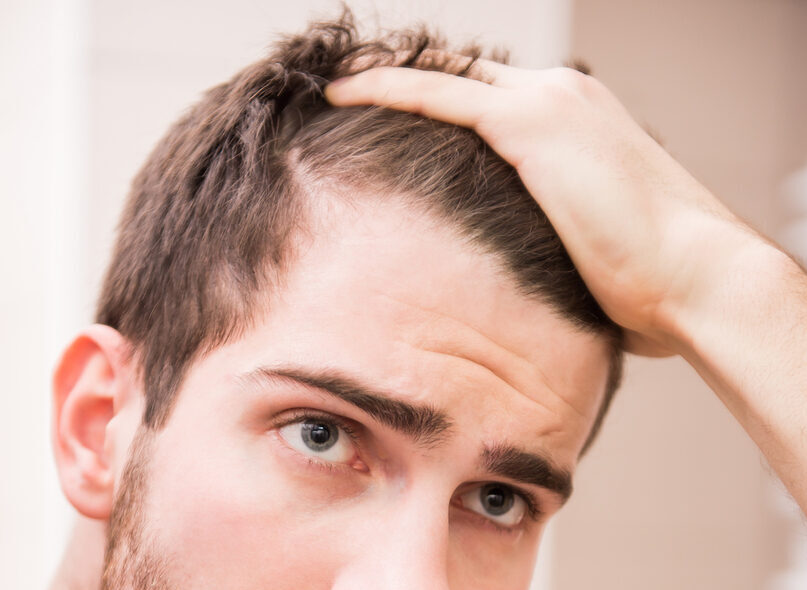Hair Transplantation
Thinning of hair or baldness is often an embarrassing situation for men and women and may cause the look of premature aging and lack of self confidence. Hair transplantation helps in restoring hair to areas of the scalp that are bald.

Causes of Hair Loss
2 types of Hair Transplant technique
Post Operative Care for Hair Transplantation
The patient has to lie down straight with one pillow and to spray the area with normal saline hourly for 7 days.
Swelling, pain, discomfort, infection, bleeding and complications like drug reaction and allergy are mostly avoidable and controllable in hands of experienced hair transplant surgeons.
Itching, pain, heaviness, numbness, clotting with good post procedure care these are avoidable.
Patient is supposed to take medicines like painkillers, anti itching and antibiotics and antacids for 3-5 days.
Donor area dressing to be opened after 48 hours and to be cleaned and antiseptic ointment to be applied for 5 days.
Avoid touching and rubbing the grafts, bending forwards, to avoid any vigorous movement of the head, expose grafts to direct sunlight for a period of 7 days.
After 7 days, you may be allowed to have head wash with gentle shampoo.
Patient can resume work from 5th day of the procedure where travelling to office is involved.
The transplanted hair may start falling in 2-3 weeks; however the underlying follicles survive start growing in 4-6 months time.it may take 9 months to one year time to notice full growth of the hair to happen.
You ask, we answer.
While age is not a barrier to having a hair transplant, a conservative approach is indicated to produce results. This ensures that your hair appears natural for the rest of your life. You don’t need to wait till you are bald to begin hair transplantation. The ideal candidate will have dense growing hair at the donor site, and realistic expectations of what the result will be
The technique of hair transplant can be applied to the scalp, eyebrows, eyelashes, beard, moustache and side locks.
For men having higher grades of hair loss and for those who are expecting dense hair, a second session of hair transplantation may be advised. In one sitting it is advisable to cover till 3000 grafts and remaining baldness can be covered in a second sitting after 6-12 months. It means in single sitting baldness grade up to 3/4 can be treated.
Old hair transplant procedures utilized large grafts that became infamous for their “pluggy” appearance and were easily noticeable to even the untrained eye. Modern techniques can produce completely natural results and you should expect nothing less than the best from your hair transplant surgeon.
An important step that anyone who suffers hair loss must take is to see their regular doctor and check for any underlying causes that are contributing to the hair loss. Many times, medications, stress and treatable illnesses can cause hair thinning. So assuming that a hair transplant could be the only solution would not be accurate.
If the client is young in age, he or she must not rush into getting a hair transplant done as the hair loss pattern needs time to mature. The transplanting hair on a scalp where the final pattern is not established can result in an unnatural look as hair loss continues.
Clients with unrealistic demands and expectations need to know and understand that the doctors cannot do anything beyond certain limits as there could be chances that the outcome may look plastic and unnatural. If all these aspects are clear to the clients they are good to go ahead with the hair transplant procedures
Since the hair follicles that are transplanted to the balding areas are taken from genetically resistant areas to going bald, they grow for the rest of the life.
The clients should be able to style their hair to their liking after a year.
After a transplant surgery the hair grows slowly and by a year it is completely grown. The hair grows normally and can be styled freely with products that are used for styling, such as sprays, gels, and mousses.
The hair can also be dyed to give it a new look. Blow drying can add volume and body to the hair. Proper styling and grooming of the hair after a hair transplant is very important as this will help the person’s personality to gain confidence
- Wash your hair with a good hair shampoo followed by use of the conditioner. This helps in maintaining the quality of the hair.
- There is a myth that frequent hair wash causes hair loss, which is untrue. If one has normal vitamins and iron levels in the body, then hair is held pretty strongly and does not fall by normal hair wash.
- If any oil has to be applied, apply it half an hour before the shampoo. This has been shown to make the hair stand healthy and withstand harsh chemicals of the shampoo.
- Use warm or cool water to avoid damaging the hair due to heat.
- Protect hair from pollution and ensure that they are covered when exposed to wind and cold weather, but allow hair to breathe and do not suffocate them by wearing a tight scarf or a cap.
- Oiling the hair is the most important thing in winter, warm the hair oil slightly and squeeze fresh lemon juice in it for better results.
- Avoid blow-drying your hair to prevent hair damage or breakage.
- Avoid brushing hair when wet as hose locks are most delicate when waterlogged.
- To prevent dryness of the scalp and retain the shine, honey can be applied to the roots of the hair for 30 mins and then washed with lukewarm water.
